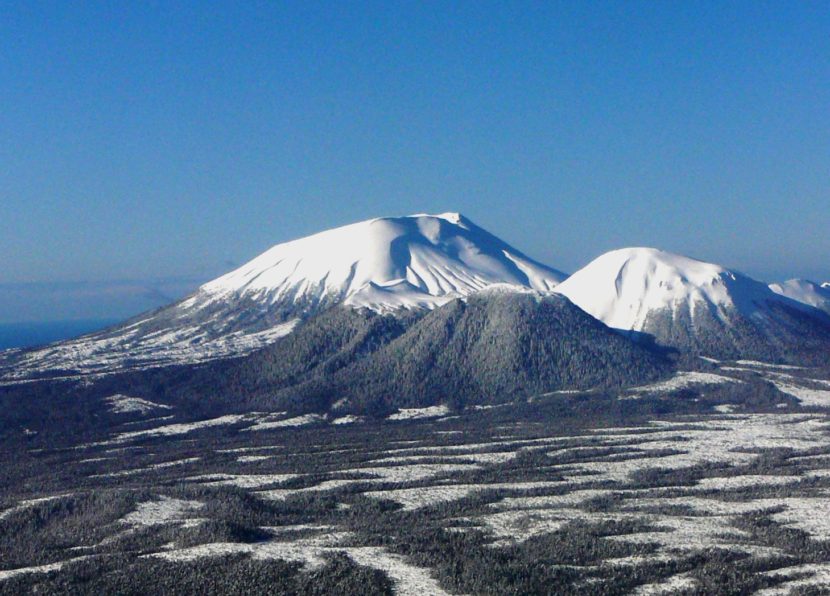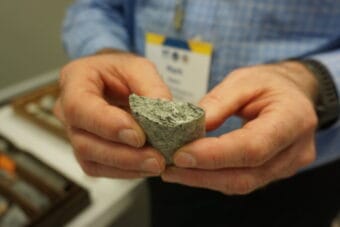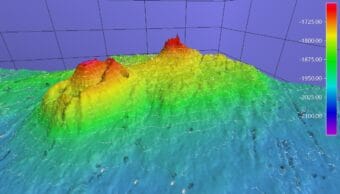
Seismologists have detected some unusual activity below the long-dormant Mt. Edgecumbe volcano near Sitka. Its last major eruption was 4,500 years ago.
The Alaska Volcano Observatory reports that a swarm of small earthquakes occurred somewhere deep below the mountain beginning on April 11 — but it’s too early to tell if that signals an eruption could be on the way.
Mt. Edgecumbe is just a few miles from the Queen Charlotte Fault, where the North American Plate and the Pacific Plate are slipping in opposite directions at the rate of about two inches per year. So there’s always a lot of ordinary, background tectonic activity in the area.
But the swarm on April 11 was out of the ordinary.
“What sort of makes this current bit of activity different is that there have been some larger earthquakes in sort of the magnitude two range that are locatable, but also many, many that are too small to be located,” said Dave Schneider, a geophysicist with the U.S. Geological Survey’s Alaska Volcano Observatory in Anchorage. The swarm consisted of these larger magnitude 2 quakes accompanied by hundreds of smaller ones – all relatively shallow, at around 5 to 10 kilometers below sea level.
Most series of earthquakes start with a larger earthquake — a mainshock — which is followed by a series of smaller earthquakes called aftershocks. When a series of earthquakes has no clear mainshock that set it off, it’s often described as a swarm.
The vast majority of the earthquakes in this swarm have been too small to be felt, though Sitka is only about 12 miles away from the crater. But some were strong enough to be located accurately with seismic stations in Sitka and elsewhere in Alaska.
“A two is a good-sized, rock-breaking earthquake at a volcano, but also nothing that’s going to make your jaw drop and be really alarmed either,” Schneider said.
Schneider says the April 11 swarm has tapered off a bit, which is a good thing. But that doesn’t mean the event is over. He says that in the medical world, they call it watchful waiting.
“Seismic swarms of volcanoes can wax and wane,” he said. “I mean, they can start off with a bang and sort of fizzle out, they can sort of start with a with a whimper and increase, or they can sort of oscillate back and forth. And so, we’re just going to be in a period of just watching and sort of seeing what’s going on.”
“We’re a long way off from an imminent eruption, or an eruption at all,” said Jacyn Schmidt, the geoscience coordinator at the Sitka Sound Science Center. When she heard from a community member that there was a quake below Mt. Edgecumbe, she called the USGS and learned about the swarm, even before the Alaska Volcano Observatory issued its preliminary report.
“I had been talking to seismologists there who assured me that the earthquakes were very small,” she said, “which is true, but it’s unusual for them to be happening beneath Mt. Edgecumbe in the pattern that they’re seeing now.”
Schmidt considers Mt. Edgecumbe an exciting research opportunity. There are no concrete plans yet, but she hopes the Science Center can assist the USGS with local monitoring of the volcano.
Dave Schneider shares Schmidt’s enthusiasm. There are 90 volcanoes in Alaska, four of which are currently erupting along the Aleutian chain. There’s even another seismic swarm occurring at the Davidoff volcano, far out in the chain.
If the activity is tied Mt. Edgecumbe, Schneider says that wouldn’t be all that unusual.
“The best case scenario for everyone — if you don’t like eruptions — is that is that a dies out,” he said.
Another possibility is more appealing to fans of eruptions, and it doesn’t necessarily mean disaster.
“The oral tradition is that 800 years ago, there was some activity, but it was minor,” Schneider said. “So if you look at the big scale of volcanic activity, minor activity is much more common than big activity.”
Schneider says that the Alaska Volcano Observatory will keep more than an eye on Mt. Edgecumbe. Satellite radar data collection is already underway to monitor the crater for deformation, in the event that magma or hydrothermal fluids cause the mountain to bulge.
Schneider says other signs that could signal a possible future eruption would more earthquakes, larger earthquakes or gas emissions.


